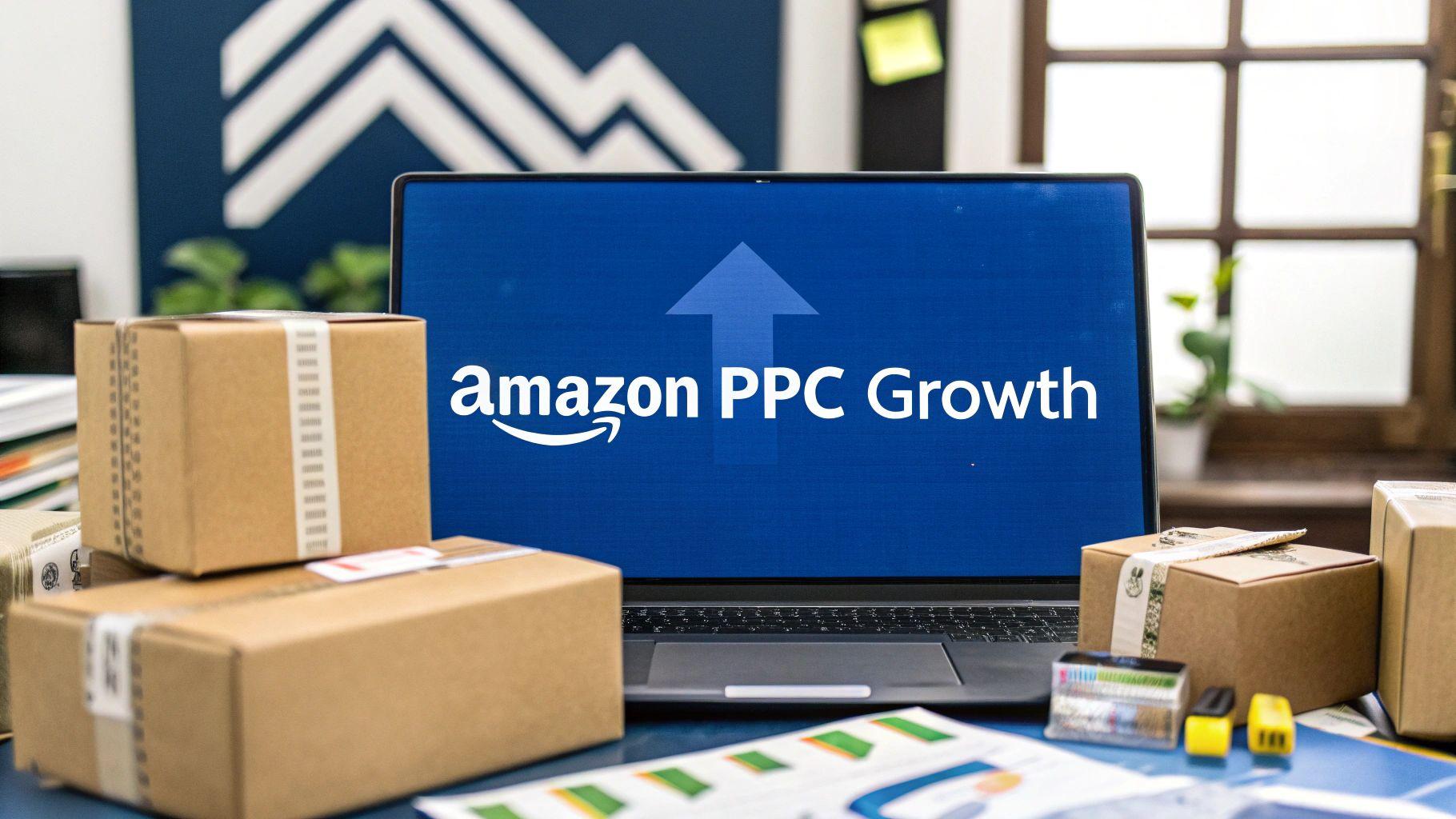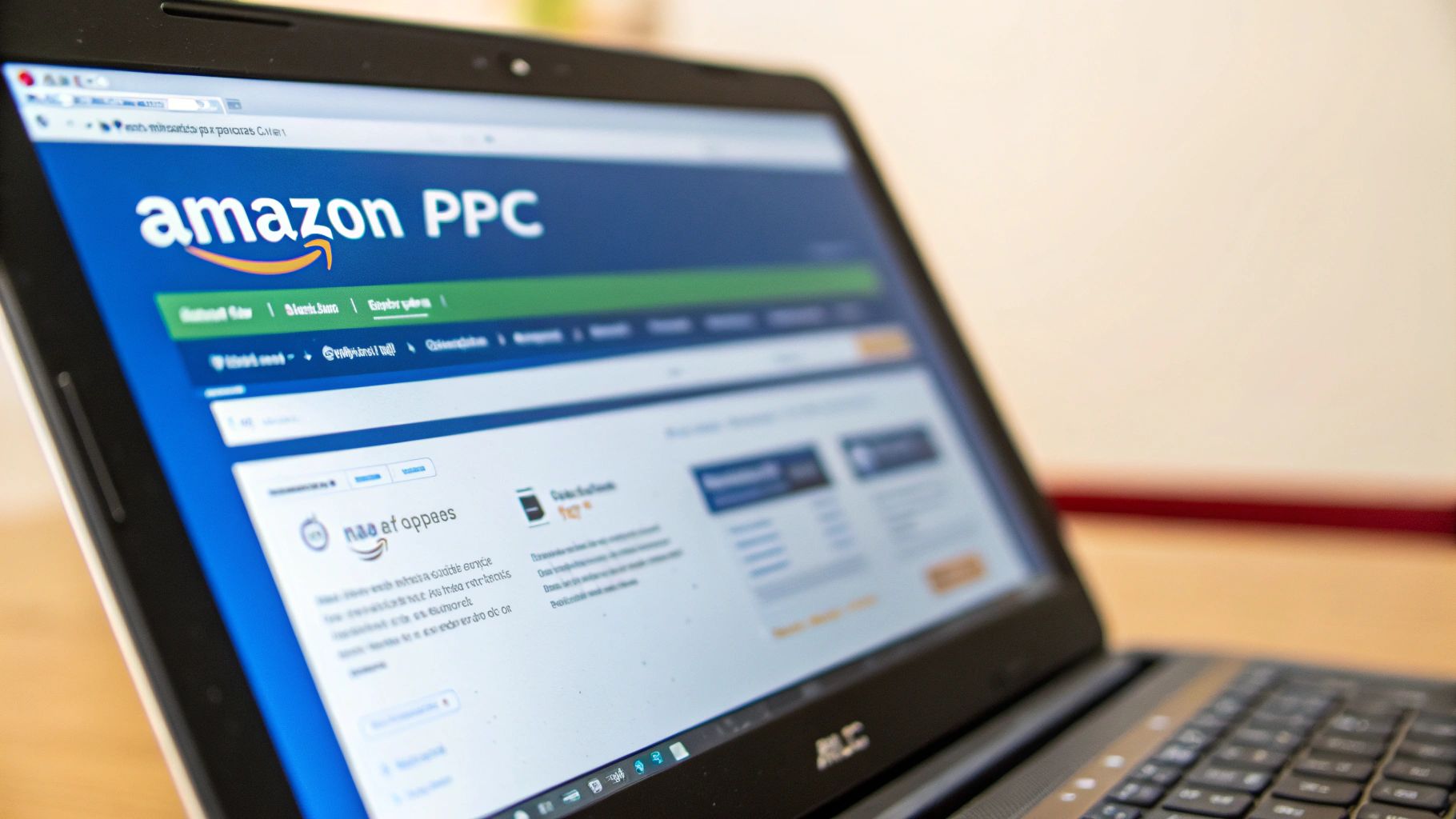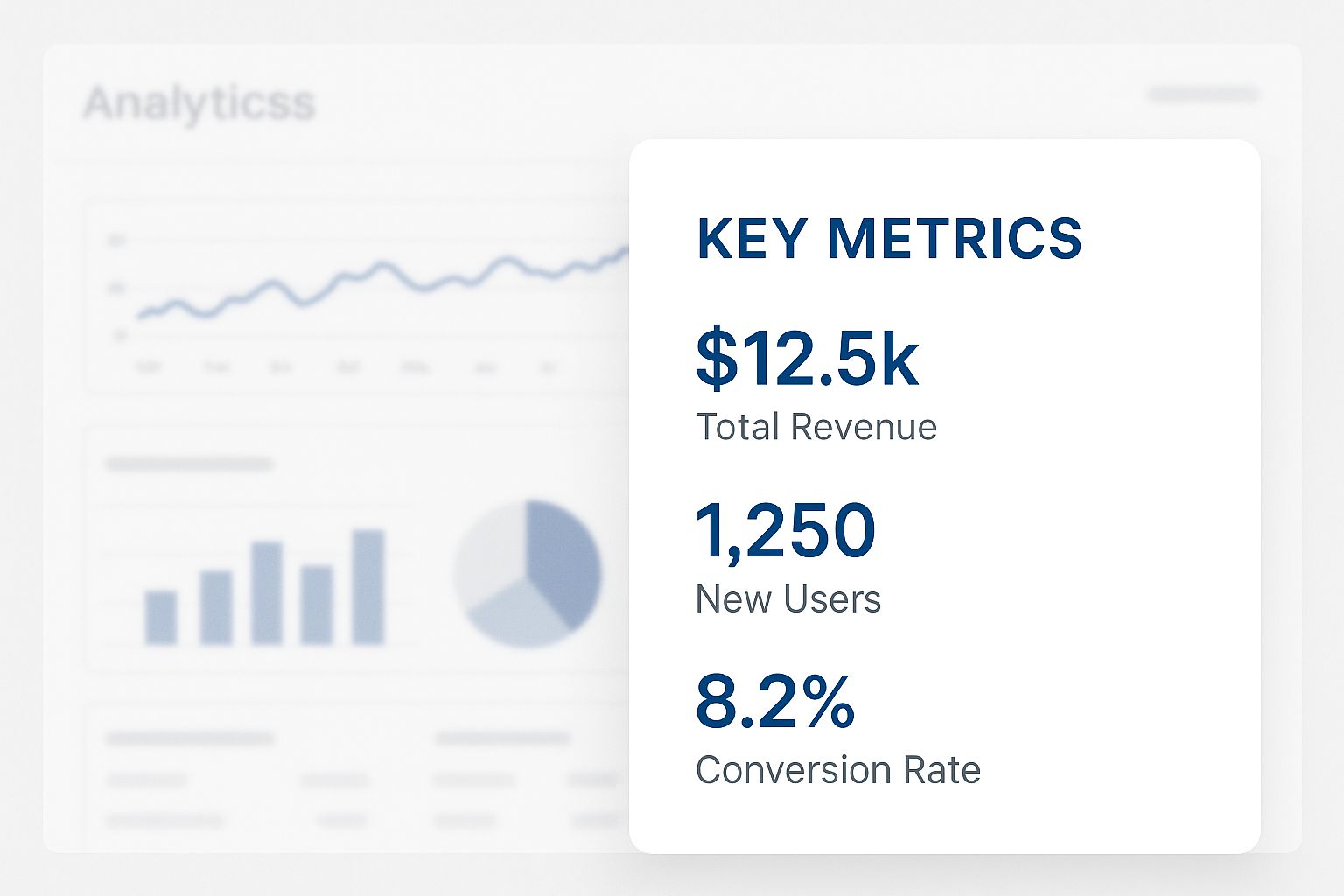What is Amazon PPC & How Does It Drive Profitable Growth?
Discover what is Amazon PPC and how it's more than ads. Learn expert strategies to boost sales, improve organic rank, and grow your brand profitably.

Think of Amazon PPC (Pay-Per-Click) as a strategic lever for growth, not just an advertising expense. It’s an advertising system where brands pay a fee each time a shopper clicks on a product ad. In a marketplace as saturated as Amazon, it's the most direct way to get your products in front of high-intent buyers, but its real value lies in its ability to fuel sustainable, profitable scale.
What Is Amazon PPC and How Does It Actually Work?

Many brands treat Amazon PPC as a cost center—a necessary evil for visibility. This view is fundamentally flawed and limits growth. Performance-driven leaders understand that PPC isn't just an ad platform; it’s the engine for the entire Amazon flywheel, directly influencing organic rank, profitability, and market share.
The mechanism is simple: you bid on keywords or target specific products, and Amazon displays your ad to relevant shoppers. You only pay when someone clicks. But the strategic power of PPC extends far beyond that initial click. A well-executed PPC strategy ignites the “flywheel effect,” a self-reinforcing cycle of growth.
Here’s the performance-first breakdown:
- Paid Clicks Drive Initial Sales Velocity: Your ads generate immediate, targeted traffic and sales, signaling demand to Amazon.
- Sales Velocity Boosts Organic Rank: This initial sales data informs Amazon’s A9 algorithm that your product is relevant and converting, rewarding you with higher organic placement.
- Organic Ranking Drives Organic Sales: Higher organic rank leads to more "free" clicks and sales, further increasing your sales velocity.
- Sustained Growth and Profitability: This cycle reinforces itself, solidifying your market position and reducing your long-term reliance on paid advertising for every sale.
This flywheel transforms ad spend from a simple expense into a strategic investment. Every dollar spent on a sophisticated campaign doesn't just return a sale; it builds a long-term, defensible asset: a high-ranking product listing that drives organic revenue.
The Foundation of Performance-First PPC
To leverage PPC effectively, leadership must shift from short-term metrics to long-term impact. Instead of only asking, "What was my Advertising Cost of Sale (ACoS) last week?" the strategic question becomes, "How is my total advertising spend impacting my total sales, organic rank, and market share over time?"
A performance-first approach means using PPC with a clear objective: to systematically improve a product's organic standing on Amazon. It’s about converting paid visibility into earned visibility, building a competitive moat that is difficult and expensive for competitors to overcome.
This is the critical difference between merely "running ads" and executing a true PPC growth strategy. It's a calculated plan to dominate high-value keywords, protect brand equity, and feed Amazon's algorithm the positive signals required for sustained success.
Amazon PPC Core Components at a Glance
To build a winning strategy, you must master the levers of the platform. This table breaks down the core components of the Amazon PPC ecosystem from a strategic, brand-relevant perspective.
| Component | Description | Strategic Importance |
|---|---|---|
| Campaign Types | Ad formats like Sponsored Products, Sponsored Brands, and Sponsored Display. | Each type serves a distinct funnel stage, from capturing bottom-of-funnel demand to building top-of-funnel brand equity. A full-funnel strategy requires a mix. |
| Bidding Models | How you pay for ads, including CPC (Cost-Per-Click) and vCPM (cost per 1,000 viewable impressions). | Your bidding model determines cost-efficiency and competitive aggression. Aligning it with campaign goals (e.g., launch vs. profitability) is crucial. |
| Targeting Options | Methods for reaching shoppers, such as keyword, product (ASIN), or category targeting. | Precision targeting is non-negotiable for maximizing ROAS. It ensures ad spend is focused on the highest-intent audiences, eliminating waste. |
| Key Metrics | Performance indicators like ACoS, TACOS (Total ACoS), Impressions, and Conversion Rate (CVR). | These metrics are the language of performance. Understanding them is essential for diagnosing issues and identifying scalable growth opportunities. |
Mastering these components allows you to move beyond simply buying clicks. You can start orchestrating a comprehensive growth strategy that uses paid advertising to create a lasting, profitable presence on Amazon.
Choosing the Right Amazon Ad Campaign
Selecting the right Amazon ad type isn’t a tactical choice; it’s a strategic one. Each campaign format is a tool designed for a specific business objective. Aligning the tool with the job is the difference between burning cash and building a defensible brand.
Are you launching a new product and need to generate initial sales velocity? Or are you a category leader defending your position from aggressive competitors? The answer dictates your campaign mix. Let’s break down the main formats from a brand leader's perspective.
Sponsored Products: The Workhorse of Your Strategy
Sponsored Product ads are the non-negotiable foundation of any serious Amazon PPC strategy. These are the native ads appearing within search results and on product detail pages. They are your primary tool for converting high-intent shoppers at the point of purchase.
Their core function is to drive sales. When a customer searches "noise-canceling headphones," a Sponsored Product ad places your product directly in their path. This is mission-critical, given that over 70% of Amazon clicks occur on the first page of search results. If you aren't visible there, you don't exist.
This ad type is essential for:
- Driving immediate sales velocity for new launches and hero products.
- Fueling the organic ranking flywheel by providing the A9 algorithm with conversion data.
- Defending brand equity by bidding on your own branded terms to block competitors from poaching customers.
Sponsored Brands: Building Authority at the Top
While Sponsored Products convert existing demand, Sponsored Brands create and shape it. These are the top-of-page banner ads featuring your logo, a custom headline, and a curated product selection. This is your brand’s billboard on Amazon’s most valuable digital real estate.
Use this format to build brand awareness and establish category authority. For a shopper searching for "organic baby food," a prominent Sponsored Brand ad can instantly position your brand as a market leader, building trust before they even click on a product. This is how you transition from being an option to being the brand of choice. To execute this, you need to identify and own the right terms, which requires disciplined Amazon PPC keyword research.
Sponsored Display: Re-Engaging and Expanding Your Reach
Sponsored Display ads are your strategic tool for reaching customers off-Amazon and defending your on-platform territory. These ads enable retargeting, allowing you to re-engage shoppers who viewed your product but didn't convert by showing them ads on third-party websites and apps. It’s a powerful method for staying top-of-mind and securing a second chance at a sale.
Strategically, Sponsored Display also enables "conquesting"—placing your ad directly on a competitor's product detail page. This is an aggressive but highly effective tactic for intercepting customers at the final moment of consideration.
The image below illustrates how key metrics align with these strategic ad types.

A winning strategy matches ad type to a business goal. For Sponsored Products, you're focused on conversion metrics and profitability. For Sponsored Brands and Display, you may prioritize new-to-brand metrics and share of voice.
Winning with Smart Targeting Strategies

The line between profitable Amazon PPC and a costly liability is drawn at targeting. This is where strategy becomes execution. Effective targeting connects your products with high-intent shoppers, eliminating wasted spend on irrelevant clicks. It's not about casting the widest net; it's about using precision to maximize return on ad spend (ROAS).
The Auto-to-Manual Campaign Flywheel
One of the most powerful and scalable targeting methodologies is the auto-to-manual flywheel. It's a systematic process for data-driven keyword discovery and optimization, effectively creating an in-house R&D lab for search terms.
Here’s the step-by-step process:
- Launch an Automatic Campaign: Let Amazon’s algorithm do the initial discovery. An auto campaign targets searches and products based on your listing content. The primary goal is not profit, but data acquisition.
- Harvest Proven Search Terms: After sufficient data collection (e.g., 1-2 weeks), analyze the search term report. Identify the exact customer queries that generated sales. These are your validated, high-performance keywords.
- Scale Winners in a Manual Campaign: Move these proven search terms into a manual campaign. Here, you gain granular control, allowing you to set specific bids for each keyword to optimize for your target ACoS or ROAS.
- Implement Negative Keywords: Concurrently, identify all irrelevant, non-converting search terms from the report. Add these as negative keywords to both your auto and manual campaigns to prevent future wasted spend.
This is a continuous optimization loop, not a one-time setup. It systematically turns low-cost discovery into highly efficient, scalable manual campaigns.
Advanced Targeting Levers for Scale
Once the flywheel is spinning, layer in advanced tactics to build a full-funnel strategy that engages shoppers at every stage.
- Keyword Match Types: Go beyond broad match. Use phrase match for controlled reach and exact match for your highest-converting, "money" keywords. This tiered structure maximizes visibility while concentrating budget on terms with the highest probability of conversion.
- Product Targeting (PAT): Attack competitors and capture complementary sales. Use ASIN targeting to place your ad on a direct competitor’s product page (conquesting). Or, target complementary categories—if you sell premium cocktail shakers, target the ASINs of popular gin and vodka brands.
The Takeaway: Use automatic campaigns for discovery, manual campaigns for scaling proven winners, and product targeting for strategic offense and defense. This structured, data-first approach provides clean data and enables confident budget allocation.
This methodical targeting is why well-managed Amazon PPC campaigns can achieve an average conversion rate of 10.33%, vastly outperforming other digital ad platforms. This is the outcome when Amazon’s high-intent audience is met with a sophisticated targeting strategy. Explore more data-backed advertising insights to benchmark your performance.
Bidding to Win in a Competitive Market
As advertising costs rise, a "bid higher" strategy is a race to the bottom. It guarantees budget depletion, not profitable growth. The key isn't outbidding the market; it's outsmarting it. This requires connecting every bid to a clear business objective and focusing on winning auctions profitably.
First, master the tools Amazon provides. Your bidding strategy dictates your aggressiveness and cost control.
Fixed Bids: You set the maximum CPC, and Amazon never exceeds it. This offers maximum control and is ideal for mature, stable campaigns where protecting profit margins is the primary goal.
Dynamic Bids: You leverage Amazon's algorithm. With "down only," Amazon lowers your bid on less-likely-to-convert clicks. With "up and down," Amazon can increase your bid by up to 100% for top-of-search placements it deems highly likely to convert. This is best for launches or campaigns where data gathering and visibility are prioritized over immediate efficiency.
Look Beyond Bids to Your Business Metrics
Choosing a bidding style is tactical. The strategic layer is informing those bids with core business metrics. Stop looking at ACoS (Advertising Cost of Sale) in a vacuum and start analyzing it alongside TACOS (Total Advertising Cost of Sale). ACoS measures ad efficiency. TACOS measures the impact of ad spend on your entire Amazon business (Ad Spend ÷ Total Revenue).
A low ACoS is meaningless if TACOS is stagnant or rising. This signals that your ads are not driving organic growth. True success is when paid advertising lifts organic rank, allowing you to decrease your TACOS over time and become less reliant on ads.
This performance-first mindset is non-negotiable as the marketplace matures. The average CPC on Amazon has climbed to around $0.98, a greater than 10% year-over-year increase. Without a profit-driven bidding strategy, brands will be priced out of the market.
From Bidding to Profitable Growth
Your bidding strategy must be fluid, adapting to your product lifecycle and business goals. For a new product launch, a high ACoS is a strategic investment in sales velocity. For a mature cash-cow product, a low ACoS is essential to maximize profitability.
The goal is to move from reactive bid management to proactive, data-driven strategy. By monitoring TACOS and understanding your break-even ACoS for each product, you can make intelligent decisions that drive sustainable growth. To master this, explore our guide on comprehensive Amazon PPC optimization. This strategic shift turns bidding from a daily chore into a powerful lever for building a profitable Amazon brand.
Measuring PPC Performance That Matters
It's dangerously easy to drown in the data inside Amazon's advertising console. A common mistake is focusing on vanity metrics like impressions and clicks. These metrics feel productive, but they don't impact your P&L. To determine if your advertising is driving business value, you must measure what directly impacts profitability and growth.
The true story of your campaign’s health is revealed by the relationship between a few key metrics. By looking past surface-level data, you can diagnose performance, identify opportunities, and understand the true return on your ad spend.
The Metrics That Define Success
Cut through the noise and focus on the KPIs that enable smarter decision-making. These are the metrics that provide a clear view of both ad efficiency and total business impact.
Advertising Cost of Sale (ACoS): (Ad Spend ÷ Ad Revenue). This is a direct measure of campaign efficiency. A lower ACoS is generally better, but "good" is always relative to your product's profit margin.
Total Advertising Cost of Sale (TACOS): (Ad Spend ÷ Total Revenue). This is the strategic KPI. It measures the impact of your advertising on your entire Amazon business. A decreasing TACOS over time is the ultimate indicator that your PPC is successfully fueling organic growth (the flywheel effect).
Conversion Rate (CVR): (Orders ÷ Clicks). This measures the effectiveness of your targeting and your product detail page. A high CVR indicates a strong product-market fit and an optimized listing. A low CVR is a critical red flag that may point to issues with price, reviews, or listing quality.
Interpreting the Data Story
These metrics are interdependent. A high ACoS may be acceptable or even desirable during a product launch to build sales velocity. Conversely, an extremely low ACoS on a mature product could signal you're being too conservative and leaving scalable growth on the table by underbidding.
The goal is to build a narrative. For example: if ACoS is stable but TACOS is decreasing, your paid ads are successfully fueling organic growth. If both ACoS and TACOS are rising, it's time to audit your targeting or address underlying conversion issues with your product listing, as detailed in our guide on what to do when your Amazon advertising is not working.
This deeper level of analysis is what separates high-growth brands. Globally, brands on Amazon generate an average of $2 in revenue for every $1 spent on PPC, demonstrating the platform's power when managed with strategic intent. In a market projected to hit $351.5 billion in spending, leveraging data correctly is the ultimate competitive advantage.
Our Recommendation: Stop managing campaigns on ACoS alone. Build a performance dashboard tracking ACoS, TACOS, and CVR weekly. This provides a holistic view of the relationship between ad spend and total business health, enabling smarter, more strategic decisions about budget allocation and long-term growth.
Got Questions About Amazon PPC? We've Got Answers.
For e-commerce and retail leaders, having the right information is critical for making sound investment decisions. Here are no-nonsense answers to some of the most common strategic questions about Amazon PPC.
What's a Realistic Starting Budget for Amazon PPC?
There is no one-size-fits-all number, but for a new product launch, a daily budget of $30 to $50 is a reasonable starting point. Frame this initial spend as an investment in data acquisition, not immediate profit. The objective is to gather enough click and conversion data to inform your optimization strategy.
For established brands, move beyond fixed daily budgets. A more sophisticated approach is to peg your advertising budget to performance goals, such as a percentage of total sales or a target TACOS. For example, a case study showed a brand allocating 10% of total revenue to PPC, which allowed them to scale ad spend dynamically as sales grew, ultimately increasing their market share by 15% in six months. This transforms advertising from a fixed cost into a flexible growth lever.
How Long Until I Actually See Results?
Initial metrics like impressions and clicks appear within 24-48 hours. However, these are leading indicators, not business results. Meaningful outcomes—a stable, profitable ACoS and a measurable lift in organic sales—require strategic patience.
Plan for the first 2 to 4 weeks as a data collection and optimization phase. You will be harvesting search terms, refining bids, and adding negative keywords. A tangible impact on total sales and organic rank typically becomes evident after 60 to 90 days of consistent, data-driven management. Amazon PPC is a long-term strategic investment, not a short-term sales tactic.
Our Takeaway: Resist the temptation to make drastic decisions based on one week of data. True PPC success is measured in months and quarters, not days. The objective is to create a sustainable growth flywheel where paid advertising progressively lifts organic rank and profitability.
What's a "Good" ACoS for My Campaigns?
The only correct answer is: it depends entirely on your product's profit margin and your strategic objective. The most critical number you must know is your break-even ACoS, which is your pre-ad profit margin. If your profit margin is 35%, any ACoS below 35% is profitable on a per-sale basis.
Industry benchmarks like 25% to 40% are often quoted but can be misleading. A "good" ACoS is one that aligns with your strategy. For a product launch, a 70% ACoS might be an excellent investment to capture market share and kickstart the flywheel. For a mature, best-selling product, the goal might be to maintain a 15% ACoS to maximize profit. It is strategy, not a generic number, that defines a good ACoS.
At Headline Marketing Agency, we reject generic benchmarks. We engineer PPC strategies grounded in your unique unit economics and business objectives. We use data to transform your ad spend into a predictable engine for profitable growth. Discover how we can help you scale on Amazon.
Ready to Transform Your Amazon PPC Performance?
Get a comprehensive audit of your Amazon PPC campaigns and discover untapped growth opportunities.